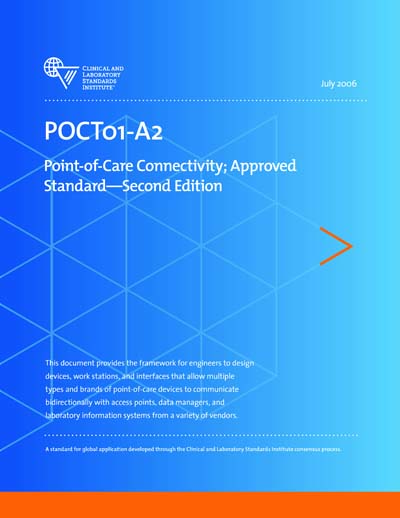Historical
POCT1-A2
Point-of Care Connectivity: Approved Standard-Second Edition
This standard establishes a set of specifications to allow seamless multivendor interoperability and communication between point-of-care devices, data concentrators, and clinical information systems. CLSI document POCT1 provides the framework for engineers to design devices, workstations, and interfaces that allow multiple types and brands of point-of-care devices to communicate bidirectionally with access points, data concentrators, and laboratory information systems from a variety of vendors.
As an interface standard, this document specifies the common communication interfaces and protocols between systems and devices. It facilitates the transfer of data to support the creation of point-of-care applications, services, and institutional policies. This document does not directly address specific pointof- care application and service level functions, such as device lockout and operator list management. This document specifies protocol, not policy. The interfaces specified support the communication required for engineers to build such application-level functionality. Specifying, building, and providing the applications to support these services are left to customers, device and information system vendors.
The only relationship of this point-of-care standard to the laboratory automation domain is through the use of the HL7 standard. In version 2.4,1 the HL7 standard was expanded to provide elements essential to laboratory automation, which also improved the HL7 standard for the entire laboratory-testing domain. These additions to HL7, along with four proposed new HL7 message triggers (see Section 4.1 in Appendix C of this CLSI standard), enable the point-of-care community to use HL7 as its electronic data interchange (EDI).
This specification also leverages several communication standards. It specifies the use of a single device transport protocol (IrDA TinyTP) running over two possible physical layers: IrDA-infrared, as specified by the Infrared Data Association (IrDA) and ISO/IEEE 11073-303002; and cable-connected, as specified by the IEEE 1073 lower-layers standard.3 This specification also utilizes local area networking standards such as IEEE 802.34 and protocols such as TCP/IP in cases where network connectivity is required.
Content Provider
Clinical And Laboratory Standards Institute [clsi]






